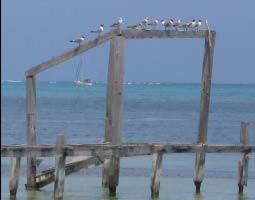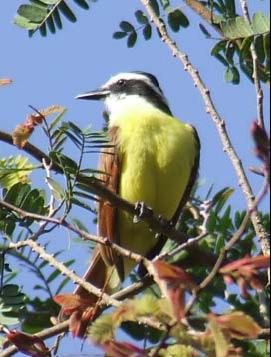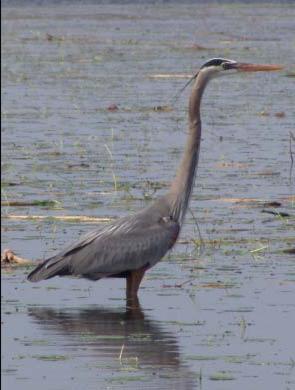
 The Laughing Gull is a medium-sized gull of North and South America. It
breeds on the Atlantic coast of North America, the Caribbean, southern California,
USA, and northern South America. Northernmost populations migrate further
south in winter, and this species occurs as a rare vagrant to Western Europe.
Laughing Gulls are a common sight along the Belize coast and this shorebird
is named for its distinctive voice, which sounds like it is laughing, “ha-haha-
The Laughing Gull is a medium-sized gull of North and South America. It
breeds on the Atlantic coast of North America, the Caribbean, southern California,
USA, and northern South America. Northernmost populations migrate further
south in winter, and this species occurs as a rare vagrant to Western Europe.
Laughing Gulls are a common sight along the Belize coast and this shorebird
is named for its distinctive voice, which sounds like it is laughing, “ha-haha- ha-haah.” Colors of gulls change with age. The adult Laughing Gull has a
black head and neck with a white belly, the sub-adult has a white head and belly
and the juvenile has a brownish head and neck. Laughing Gulls breed in coastal
marshes and ponds. The large nest, made largely from grasses, is constructed
on the ground. The three or four greenish eggs are incubated for about three
weeks. These gulls are omnivores and will scavenge as well as seeking suitable
small prey.
ha-haah.” Colors of gulls change with age. The adult Laughing Gull has a
black head and neck with a white belly, the sub-adult has a white head and belly
and the juvenile has a brownish head and neck. Laughing Gulls breed in coastal
marshes and ponds. The large nest, made largely from grasses, is constructed
on the ground. The three or four greenish eggs are incubated for about three
weeks. These gulls are omnivores and will scavenge as well as seeking suitable
small prey.

 Osprey, also called fish hawk, is a
fish-eating bird. Ospreys feed by making
spectacular plunges into water from
heights of 50 to 100 feet (15 to 30
meters). They hit the water feet first
with a great splash and seize a fish with
their long, slender claws. These birds live throughout the world along rivers,
lakes, seacoasts, and bays. Ospreys in northern regions migrate to warm areas
for the winter. The osprey is a large bird of prey, about 2 feet long, with a
wingspread of nearly 6 feet. It has a dark brown back with a whitish head and a
white chest with a few streaks of dark brown.
Osprey, also called fish hawk, is a
fish-eating bird. Ospreys feed by making
spectacular plunges into water from
heights of 50 to 100 feet (15 to 30
meters). They hit the water feet first
with a great splash and seize a fish with
their long, slender claws. These birds live throughout the world along rivers,
lakes, seacoasts, and bays. Ospreys in northern regions migrate to warm areas
for the winter. The osprey is a large bird of prey, about 2 feet long, with a
wingspread of nearly 6 feet. It has a dark brown back with a whitish head and a
white chest with a few streaks of dark brown.

It has a dark brown eyeline broadening
behind each eye. Ospreys nest in trees, jagged rocks, or low bushes, or on
the ground. Ospreys build the largest nests of any North American birds, with
some measure up to 6 feet (1.8 meters) high. Nest-building materials include
seaweed, sticks, bones, or driftwood. Ospreys usually lay three eggs and the
incubation of the eggs lasts about 37 days.
 The Great Kiskadee is a large, striking bird whose name is derived
from its call which sounds very much like French for “What are you
saying” ...”Quest-ce-que dit”, or kis-ka-dee. It is a robin-sized bird
about ten inches in length with black and white stripes on the crown and
sides of its head. It has a white line above its eyes. Its chest and undersides
are a bright yellow and its throat is white. Its back and wings are
brown and its bill and legs are black. They usually travel in pairs and
are common throughout Latin America. Although the Great Kiskadee is
a member of the flycatcher family, this bird breaks the rules for the
flycatcher family. Besides catching insects in the air, it also grabs lizards
from tree trunks, hops about in trees and shrubs to eat berries, and
will even perch on branches that are low over water to plunge in for fish
and tadpoles. It will dine on beetles, wasps, grasshoppers, bees and
moths and will eat mice and frogs. It lives near rivers, streams, and
lakes bordered with dense vegetation and also in more open country and
in parks in most of its range.
The Great Kiskadee is a large, striking bird whose name is derived
from its call which sounds very much like French for “What are you
saying” ...”Quest-ce-que dit”, or kis-ka-dee. It is a robin-sized bird
about ten inches in length with black and white stripes on the crown and
sides of its head. It has a white line above its eyes. Its chest and undersides
are a bright yellow and its throat is white. Its back and wings are
brown and its bill and legs are black. They usually travel in pairs and
are common throughout Latin America. Although the Great Kiskadee is
a member of the flycatcher family, this bird breaks the rules for the
flycatcher family. Besides catching insects in the air, it also grabs lizards
from tree trunks, hops about in trees and shrubs to eat berries, and
will even perch on branches that are low over water to plunge in for fish
and tadpoles. It will dine on beetles, wasps, grasshoppers, bees and
moths and will eat mice and frogs. It lives near rivers, streams, and
lakes bordered with dense vegetation and also in more open country and
in parks in most of its range.
 The Great Blue Heron stands three to four feet tall and has a wingspan of
almost six feet. It has blue-gray feathers on most of its body and a plume of
feathers on its chest and back. It has a long, pointed yellow bill and long legs.
Adults have white on the top of their heads and long black plumes above their
eyes. The largest and most widespread heron in North America, the Great
Blue Heron can be found along the ocean shore or the edge of a small inland
pond. An all white form is found from southern Florida into the Caribbean,
and used to be considered a separate species, the “Great White Heron.” An
The Great Blue Heron stands three to four feet tall and has a wingspan of
almost six feet. It has blue-gray feathers on most of its body and a plume of
feathers on its chest and back. It has a long, pointed yellow bill and long legs.
Adults have white on the top of their heads and long black plumes above their
eyes. The largest and most widespread heron in North America, the Great
Blue Heron can be found along the ocean shore or the edge of a small inland
pond. An all white form is found from southern Florida into the Caribbean,
and used to be considered a separate species, the “Great White Heron.” An adaptable bird whose large size enables it to feed on a variety of prey-from
large fish and frogs to mice, small birds, and insects-the Great Blue has one
of the widest ranges of any North American heron. This wide choice of food
enables it to remain farther north during the winter than other species, wherever
there is open water, although such lingering birds may fall victim to
severe weather. Most Great Blues nest in colonies in tall trees; their presence
is often unsuspected until the leaves fall and the groups of saucer-shaped
nests are exposed to view. In late summer young herons disperse widely and
may be encountered at small ponds, in mountain waters, or even in backyard
pools-wherever fish are plentiful.
adaptable bird whose large size enables it to feed on a variety of prey-from
large fish and frogs to mice, small birds, and insects-the Great Blue has one
of the widest ranges of any North American heron. This wide choice of food
enables it to remain farther north during the winter than other species, wherever
there is open water, although such lingering birds may fall victim to
severe weather. Most Great Blues nest in colonies in tall trees; their presence
is often unsuspected until the leaves fall and the groups of saucer-shaped
nests are exposed to view. In late summer young herons disperse widely and
may be encountered at small ponds, in mountain waters, or even in backyard
pools-wherever fish are plentiful.
Click here to return to the main page for Caribbean Critters

